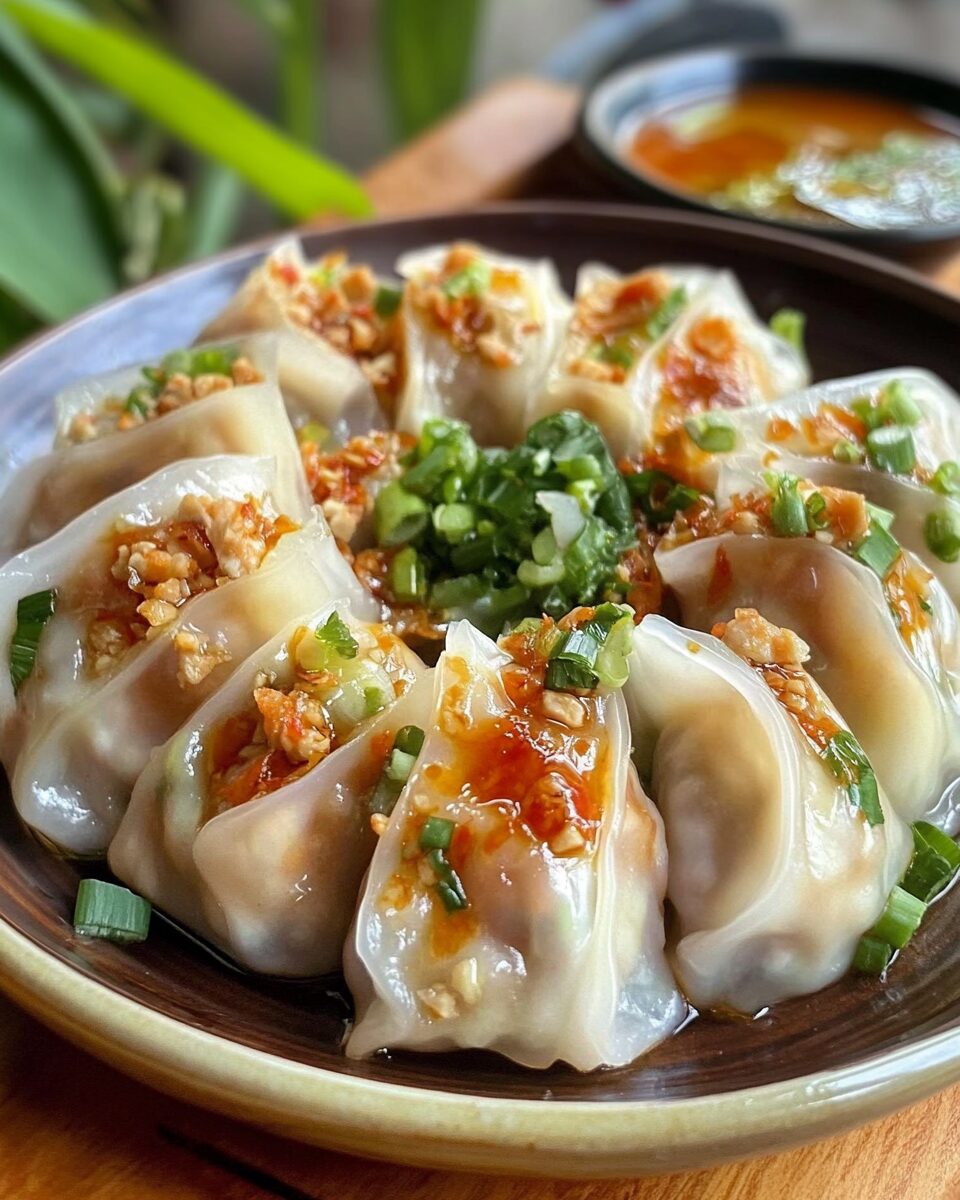Kanom Jeeb, Thailand’s take on steamed dumplings, is a dish that balances delicate flavors and textures perfectly. The juicy filling, made with a blend of ground pork, shrimp, and aromatic seasonings, is encased in a tender wonton wrapper and gently steamed until perfectly cooked. Finished with crispy fried garlic and fresh cilantro, every bite delivers a satisfying mix of umami, crunch, and freshness.
This dish is a staple in Thai street food culture, often served with a side of tangy soy sauce or sweet chili sauce for dipping. Whether enjoyed as an appetizer, snack, or part of a meal, these steamed dumplings bring an authentic taste of Thailand right to your table. Plus, they’re surprisingly easy to make at home, making them a great choice for your next cooking adventure!
Full Recipe
Ingredients:
- 1/2 pound ground pork
- 1/4 cup shrimp, finely chopped
- 2 tablespoons water chestnuts, finely chopped
- 1 tablespoon soy sauce
- 1 teaspoon oyster sauce
- 1/2 teaspoon white pepper
- 1/2 teaspoon sesame oil
- 1/2 teaspoon sugar
- 1 teaspoon cornstarch
- 2 cloves garlic, minced
- 1 green onion, finely chopped
- 15-20 wonton wrappers
- 1 egg yolk (for sealing)
- 2 tablespoons fried garlic, for garnish
- Chopped cilantro, for garnish
- Soy sauce or sweet chili sauce for dipping
Directions:
- In a mixing bowl, combine the ground pork, chopped shrimp, water chestnuts, soy sauce, oyster sauce, white pepper, sesame oil, sugar, cornstarch, minced garlic, and green onions. Mix well until fully incorporated.
- Place about a teaspoon of filling in the center of each wonton wrapper. Gather the edges and gently press them together to form an open dumpling shape. Use a bit of egg yolk to seal the wrappers if needed.
- Arrange the dumplings in a steamer lined with parchment paper or cabbage leaves to prevent sticking.
- Steam over medium heat for 10-12 minutes, or until the filling is cooked through.
- Transfer the dumplings to a serving plate and garnish with fried garlic and chopped cilantro.
- Serve with soy sauce or sweet chili sauce on the side for dipping.
Prep Time: 20 minutes | Cooking Time: 12 minutes | Total Time: 32 minutes
Kcal: 120 kcal per serving | Servings: 4 servings
Kanom Jeeb: The Traditional Thai Steamed Dumplings
Kanom Jeeb, the Thai version of steamed dumplings, is a beloved street food found across Thailand. These delightful dumplings are filled with a savory blend of ground pork, shrimp, and aromatic seasonings, then wrapped in delicate wonton wrappers before being gently steamed to perfection. Known for their rich umami taste and tender texture, Kanom Jeeb is often enjoyed as an appetizer or snack, served with a side of dipping sauce to enhance its flavor.
Unlike other Asian dumplings that may be pan-fried or boiled, Kanom Jeeb is uniquely steamed, allowing the natural flavors of the filling to shine through while maintaining a soft and juicy texture. The final touch of crispy fried garlic and fresh cilantro gives these dumplings an added depth of flavor, making them irresistible for any Thai food lover.
The Origins and Cultural Significance of Kanom Jeeb
Kanom Jeeb is deeply rooted in Thailand’s culinary traditions, but its origins trace back to Chinese influence. The dish is similar to Shumai, a Cantonese-style dumpling commonly found in dim sum restaurants. Over time, Thailand adopted and modified the recipe, incorporating local ingredients and seasonings to create a distinct variation that reflects Thai flavors.
Thai cuisine is known for balancing the five essential tastes—sweet, sour, salty, bitter, and umami—and Kanom Jeeb is no exception. The combination of pork and shrimp provides a rich umami base, while the addition of soy sauce, oyster sauce, and white pepper brings in layers of depth. Unlike the Chinese version, which may include mushrooms or bamboo shoots, the Thai version often includes water chestnuts for a mild crunch, making the texture even more enjoyable.
In Thailand, Kanom Jeeb is widely available from street vendors, night markets, and small eateries. They are often sold in small portions, making them an ideal snack for on-the-go eating. Whether served as part of a larger meal or enjoyed alone, these dumplings remain a favorite among both locals and tourists.
What Makes Kanom Jeeb Special?
One of the reasons Kanom Jeeb stands out is its simple yet flavorful filling. The blend of pork and shrimp creates a juicy bite, while seasonings like soy sauce and oyster sauce bring out the natural flavors of the meat. Another key element is the steaming process, which keeps the dumplings light and tender while preserving their rich taste.
Another defining characteristic of Kanom Jeeb is its presentation. The dumplings are typically arranged in bamboo steamers or on small plates, garnished with crispy fried garlic and fresh cilantro. This not only adds to the flavor but also enhances the visual appeal of the dish.
Kanom Jeeb is also highly versatile. While pork and shrimp are the traditional fillings, modern variations include chicken, crab, or even vegetarian options with tofu and mushrooms. The dipping sauce can also be customized, ranging from a simple soy sauce mix to a spicy Thai chili sauce.
How to Serve and Enjoy Kanom Jeeb
Kanom Jeeb is best served fresh from the steamer, allowing the wrappers to remain soft and the filling to stay juicy. While they can be eaten on their own, the experience is elevated with a flavorful dipping sauce. Some common dipping sauce options include:
- Soy Sauce Mix: A simple combination of soy sauce, vinegar, and a touch of sugar.
- Sweet Chili Sauce: A classic Thai condiment that adds a perfect balance of sweetness and spice.
- Spicy Garlic Sauce: A blend of minced garlic, chilies, soy sauce, and lime juice for a tangy kick.
For an authentic Thai experience, Kanom Jeeb is often enjoyed with a side of pickled vegetables or fresh cucumber slices. This helps cleanse the palate and adds a refreshing contrast to the rich, savory dumplings.
Tips for Making the Perfect Kanom Jeeb
- Use Fresh Ingredients – The quality of the pork and shrimp is crucial in achieving a flavorful and juicy filling. Always opt for fresh ingredients whenever possible.
- Do Not Overfill the Wrappers – Overstuffing the dumplings can cause them to break during steaming. Use just enough filling to allow the wrapper to fold properly.
- Ensure Proper Sealing – Lightly pressing the wrappers together ensures they stay intact while steaming. A bit of egg yolk can help seal the edges.
- Steam with Care – To prevent sticking, line the steamer with parchment paper or cabbage leaves. Avoid overcrowding the dumplings to allow even cooking.
- Customize the Flavor – Adjust the seasoning of the filling according to personal preference. Adding a bit of ginger or lemongrass can provide a unique Thai twist.
Pairing Kanom Jeeb with Other Thai Dishes
Kanom Jeeb can be part of a larger Thai meal, making it an excellent appetizer before a more filling dish. Here are some great Thai dishes to pair with Kanom Jeeb:
- Pad Thai – The combination of sweet, tangy, and nutty flavors complements the savory dumplings.
- Tom Yum Soup – A spicy and sour Thai soup that provides a contrast to the dumplings’ richness.
- Thai Fried Rice – A simple yet flavorful rice dish that pairs well with the light texture of Kanom Jeeb.
- Green Papaya Salad (Som Tam) – A refreshing, crunchy salad that balances the soft dumplings.
For those who love Thai cuisine, combining Kanom Jeeb with other dishes creates a well-rounded meal that highlights different textures and flavors.
Health Benefits of Steamed Dumplings
While dumplings are often seen as indulgent, Kanom Jeeb is a healthier option compared to fried appetizers. Because they are steamed, they contain less oil and fat, making them a light and nutritious snack. The combination of protein from pork and shrimp, along with vitamins from water chestnuts and garlic, makes these dumplings both satisfying and wholesome.
Additionally, the use of herbs and spices such as cilantro and white pepper provides antioxidants and digestive benefits. For those looking to make this dish even healthier, using lean ground chicken or adding more vegetables to the filling can reduce the calorie content without sacrificing flavor.
Conclusion
Kanom Jeeb is a delightful Thai steamed dumpling that captures the essence of Thai street food. With its juicy pork and shrimp filling, soft wonton wrapper, and aromatic toppings, it’s no surprise that this dish has become a favorite among food lovers.
What makes Kanom Jeeb truly special is its balance of flavors and textures, along with its versatility in preparation and serving. Whether enjoyed as a snack, appetizer, or part of a full Thai meal, these dumplings are an excellent addition to any table.
For those looking to bring authentic Thai flavors into their home, making Kanom Jeeb from scratch is a rewarding and enjoyable experience. With fresh ingredients, proper steaming techniques, and the right dipping sauce, anyone can create these delicious dumplings with ease.
So, the next time you’re craving Thai cuisine, try making Kanom Jeeb—an irresistible dish that brings the warmth and flavors of Thailand straight to your kitchen.






